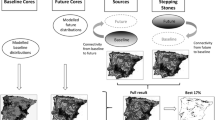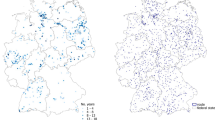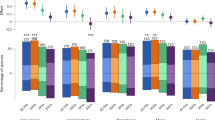Abstract
Projections of species’ distributions in future climates can aid adaptive conservation strategies. Although presence-absence or presence-only data have been extensively used for this purpose, modelling changes in spatial patterns of abundance provides a more sensitive tool for estimating species’ vulnerabilities to climate impacts. We used abundance data from citizen science bird surveys in the UK and France to predict spatial patterns of future climatic suitability throughout Great Britain for 124 breeding bird species. We project that climatic suitability of Great Britain will increase for 44% of species and decline for 9% of species by 2080. Of the latter group, most are already red-listed for their severe long-term population declines. If our suitability projections translate into population changes, by 2080, conservation listing status will worsen for 10 species and improve for 28 species. Projected changes in climatic suitability translate into net gains of species abundance in northern and western areas and high turnover in community composition throughout Britain, particularly under medium- and high-emission scenarios. In conclusion, community-wide projections of changes in climatic suitability based on abundance indicate that bird assemblages throughout Great Britain will be impacted by climate change and that species already of concern are likely to be impacted hardest. Of the species projected to benefit, the ability of currently red-listed species to respond positively to climate without other interventions is unclear.


Similar content being viewed by others
References
Aebischer NJ, Ewald JA (2004) Managing the UK Grey Partridge Perdix perdix recovery: population change, reproduction, habitat and shooting. Ibis 146(S2):181–191
Armstrong JS (2001) Combining forecasts. In: Armstrong JS (ed) Principle of Forecasting. Kluwer Academic Publishers, Norwell, pp 417–439
Baddeley A, Turner R (2005) spatstat: an R package for analyzing spatial point patterns. J Stat Softw 12:1–42
Balmer DE, Gillings S, Caffrey BJ, Swann RL, Downie IS, Fuller RJ (2013) Bird atlas 2007–11: the breeding and wintering birds of Britain and Ireland. BTO, Thetford
Barbet-Massin M, Thuiller W, Jiguet F (2012) The fate of European breeding birds under climate, land-use and dispersal scenarios. Glob Chang Biol 18:881–890
Beale CM, Burfield IJ, Sim IMW, Pearce-Higgins JW RGW, Grant MC (2006) Climate change may account for the decline in British ring ouzels Turdus torquatus. J Anim Ecol 75:826–835
Bellard C, Bertelsmeier C, Leadley P, Thuiller W, Courchamp F (2012) Impacts of climate change on the future of biodiversity. Ecol Lett 15:365–377
Bivand RG, Pebesma EJ, Gómez-Rubio V (2008) Applied spatial data analysis with R. Springer, New York
Bray JR, Curtis JT (1957) An ordination of upland forest communities of southern Wisconsin. Ecol Monogr 27:325–349
Breiman L (2001) Random forests. Mach Learn 45:5–32
Burnham KP, Anderson DR (2002) Model selection and multimodel inference: a practical information-theoretic approach. Springer-Verlag, New York
Carroll MJ, Dennis P, Pearce-Higgins JW, Thomas CD (2011) Maintaining northern peatland ecosystems in a changing climate: effects of soil moisture, drainage and drain blocking on craneflies. Glob Chang Biol 17:2991–3001
Chamberlain DE, Fuller RJ (2001) Contrasting patterns of change in distribution and abundance of farmland birds in relation to farming system in lowland Britain. Glob Ecol Biogeogr 10:399–409
Charmantier A, McCleery RH, Cole LR, Perrins C, Kruuk LEB, Sheldon BC (2008) Adaptive phenotypic plasticity in response to climate change in a wild bird population. Science 320:800–803
Core Team R (2014) R: a language and environment for statistical computing. R Foundation for Statistical Computing, Vienna http://www.R-project.org. Accessed 6 July 2017
Davey CM, Chamberlain DE, Newson SE, Noble DG, Johnston A (2012) Rise of the generalists: evidence for climate driven homogenization in avian communities. Glob Ecol Biogeogr 21:568–578
Davey CM, Devictor V, Jonzén N, Lindström Å, Smith HG (2013) Impact of climate change on communities: revealing species’ contribution. Journal of Anim Ecol 82:551–561
Devictor V, van Swaay C, Brereton T et al (2012) Differences in the climatic debts of birds and butterflies at a continental scale. Nat Clim Chang 2:121–124
Eaton MA, Aebischer NJ, Brown AF, Hearn RD, Lock L, Musgrove AJ, Noble DG, Stroud DA, Gregory RD (2015) Birds of Conservation Concern 4: the population status of birds in the UK, Channel Islands and Isle of Man. Brit Birds 108:708–746
European Bird Census Council (2015) Common bird monitoring schemes in Europe http://www.ebcc.info/index.php?a=cat.13. Accessed 6 July 2017
European Environment Agency (2012) Corine Land Cover 2006 raster data http://www.eea.europa.eu/data-and-maps/data/corine-land-cover-2006-raster-2. Accessed 6 July 2017
Fuller RJ (2012) Birds and habitat: relationships in changing landscapes. Cambridge University Press, Cambridge
Fuller RJ, Noble DG, Smith KW, Vanhinsbergh D (2005) Recent declines in populations of woodland birds in Britain: a review of possible causes. Brit Birds 98:116–143
Gillings S, Balmer DE, Fuller RJ (2015) Directionality of recent bird distribution shifts and climate change in Great Britain. Glob Chang Biol 21:2155–2168
Grömping U (2009) Variable importance assessment in regression: linear regression versus random forest. Am Stat 63:308–319
Guisan A, Zimmermann NE (2000) Predictive habitat distribution models in ecology. Ecol Model 135:147–186
Hadley Centre for Climate Prediction and Research (2008) UKCP09, Met Office Hadley Centre Regional Climate Model (HadRM3-PPE) Data. NCAS British Atmospheric Data Centre
Hagemeijer EJM, Blair MJ (eds) (1997) The EBCC Atlas of European Breeding Birds: their distribution and abundance. T & A D Poyser, London
Harris S, Massimino D, Newson SE, Eaton MA, Marchant JH, Balmer DE, Noble DG, Gillings S, Procter D, Pearce-Higgins JW (2016) The Breeding Bird Survey 2015, BTO Research Report 687. British Trust for Ornithology, Thetford
Harrison PJ, Yuan Y, Buckland ST, Oedekoven CS, Elston DA, Brewer MJ, Johnston A, Pearce-Higgins JW (2016) Quantifying turnover in biodiversity of British breeding birds. J Appl Ecol 53:469–478
Hastie T, Tibshirani R, Friedman J (2009) The elements of statistical learning. Springer-Verlag, New York
Hiley JR, Bradbury RB, Holling M, Thomas CD (2013) Protected areas act as establishment centres for species colonising the United Kingdom. Proc R Soc B 280:20122310
Howard C, Stephens PA, Pearce-Higgins JW, Gregory RD, Willis SG (2014) Improving species distribution models: the value of data on abundance. Methods Ecol Evol 5:506–513
Huntley B, Green RE, Collingham YC, Willis SG (2007) A Climatic Atlas of European Breeding Birds. Lynx Edicions, Barcelona
IPCC (2000) Emissions scenarios. Cambridge University Press, Cambridge
IPCC (2014) Climate change 2014: impacts, adaptation, and vulnerability. Part A: global and sectoral aspects. Contribution of working group II to the fifth assessment report of the intergovernmental panel on climate change. Cambridge University Press
Jacobson MZ (2005) Fundamentals of atmospheric modeling. Cambridge University Press, Cambridge
Jarema SI, Samson J, McGill BJ, Humphries MM (2009) Variation in abundance across a species’ range predicts climate range responses in the range interior will exceed those at the edge: a case study with North American beaver. Glob Change Biol 15:508–522
Jetz W, Wilcove DS, Dobson AP (2007) Projected impacts of climate change and land-use change on the global biodiversity of birds. PLoS Biol 5:e157
Jiguet F, Devictor V, Julliard R, Couvet D (2012) French citizens monitoring ordinary birds provide tools for conservation and ecological sciences. Acta Oecol 44:58–66
Johnston A, Ausden M, Dodd AM et al (2013) Observed and predicted effects of climate change on species abundance in protected areas. Nat Clim Chang 3:1055–1061
Jones PD, Harris I (2013) CRU TS3.21: climatic research unit (CRU) time-series (TS) version 3.21 of high resolution gridded data of month-by-month variation in climate (Jan. 1901–Dec. 2012), NCAS British Atmospheric Data Centre, 24 September 2013. https://doi.org/10.5285/D0E1585D-3417-485F-87AE-4FCECF10A992
Le Viol I, Jiguet F, Brotons L, Herrando S, Lindström Å, Pearce-Higgins JW, Reif J, Van Turnhout C, Devictor V (2012) More and more generalists: two decades of changes in the European avifauna. Biol Lett 8:780–782
Lindström Å, Green M, Paulson G, Smith HG, Devictor V (2013) Rapid changes in bird community composition at multiple temporal and spatial scales in response to recent climate change. Ecography 36:313–322
Massimino D, Johnston A, Pearce-Higgins JW (2015) The geographical range of British birds expands during 15 years of warming. Bird Study 62:523–534
McCullagh P, Nelder JA (1989) Generalized linear models. Chapman and Hall, London
O’Grady JJ, Reed DH, Brook BW, Frankham R (2004) What are the best correlates of predicted extinction risk? Biol Conserv 118:513–520
Oedekoven CS, Elston DA, Harrison PJ, Brewer MJ, Buckland ST, Johnston A, Foster S, Pearce-Higgins JW (2017) Attributing changes in the distribution of species abundance to weather variables using the example of British breeding birds. Methods Ecol Evol (in press)
Oliver TH, Gillings S, Pearce-Higgins JW, Brereton T, Crick HQP, Duffield S, Morecroft MD, Roy DB (2017) Large extents of intensive land use limit community reorganisation during climate warming. Glob Chang Biol 23:2272–2283
Pearce-Higgins JW, Beale CM, Oliver TH et al (2017) A national-scale assessment of climate change impacts on species: assessing the balance of risks and opportunities for multiple taxa. Biol Conserv 213:124–134
Pearce-Higgins JW, Eglington SM, Martay B, Chamberlain DE (2015) Drivers of climate change impacts on bird communities. J Anim Ecol 84:943–954
Pearce-Higgins JW, Green RE (2014) Birds and climate change. Cambridge University Press, Cambridge
Renwick AR, Massimino D, Newson SE, Chamberlain DE, Pearce-Higgins JW, Johnston A (2012) Modelling changes in species’ abundance in response to projected climate change. Divers Distrib 18:121–132
Sexton DMH, Harris G, Murphy J (2010) UKCP09: spatially coherent projections. Met Office Hadley Centre, Exeter
Shoo LP, Williams SE, Hero JM (2005) Climate warming and the rainforest birds of the Australian wet tropics: using abundance data as a sensitive predictor of change in total population size. Biol Conserv 125:335–343
Thomas CD, Cameron A, Green RE et al (2004) Extinction risk from climate change. Nature 427:145–148
Thuiller W (2003) BIOMOD—optimizing predictions of species distributions and projecting future shifts under global change. Glob Change Biol 9:1353–1362
United States Geological Survey (1996) Global 30 Arc-Second Elevation (GTOPO30) https://lta.cr.usgs.gov/GTOPO30. Accessed 6 July 2017
Vos CC, Berry P, Opdam P, Baveco H, Nijhof B, O’Hanley J, Bell C, Kuipers H (2008) Adapting landscapes to climate change: examples of climate-proof ecosystem networks and priority adaptation zones. J Appl Ecol 45:1722–1731
Wiens JA, Stralberg D, Jongsomjit D, Howell CA, Snyder MA (2009) Niches, models, and climate change: assessing the assumptions and uncertainties. Proc Nat Acad Sci USA 106:19729–19736
Acknowledgements
We warmly thank the members and volunteers of the British Trust for Ornithology and the Centre de Recherches sur la Biologie des Populations d’Oiseaux who have contributed to the Breeding Bird Survey and the Suivi Temporel des Oiseaux Communs of French birds. The Breeding Bird Survey and this research are funded jointly by the British Trust for Ornithology, the Joint Nature Conservation Committee (on behalf of the Council for Nature Conservation and Countryside, Natural England, Natural Resources Wales and Scottish Natural Heritage) and the Royal Society for Protection of Birds. We also thank two anonymous reviewers for insightful and constructive comments on the manuscript.
Funding
This research was funded jointly by the British Trust for Ornithology, the Joint Nature Conservation Committee (on behalf of the Council for Nature Conservation and Countryside, Natural England, Natural Resources Wales and Scottish Natural Heritage) and the Royal Society for Protection of Birds.
Author information
Authors and Affiliations
Corresponding author
Ethics declarations
Conflict of interest
The authors declare that they have no conflict of interest.
Rights and permissions
About this article
Cite this article
Massimino, D., Johnston, A., Gillings, S. et al. Projected reductions in climatic suitability for vulnerable British birds. Climatic Change 145, 117–130 (2017). https://doi.org/10.1007/s10584-017-2081-2
Received:
Accepted:
Published:
Issue Date:
DOI: https://doi.org/10.1007/s10584-017-2081-2




